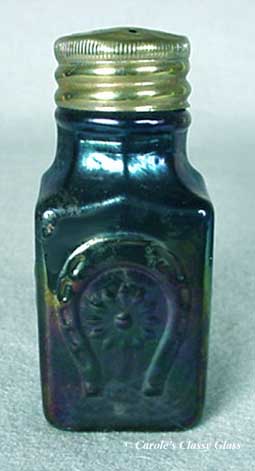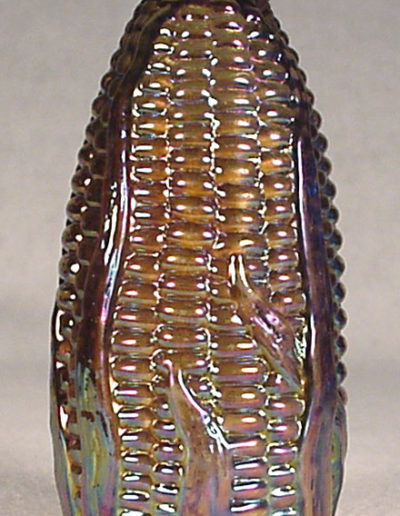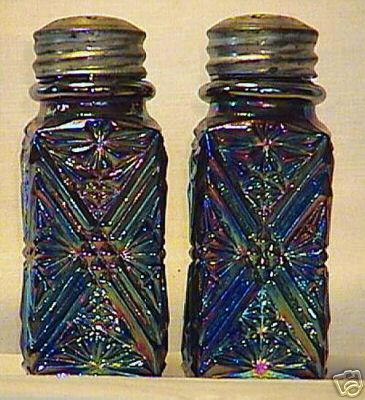Early Carnival Shakers: Exceptional Colors
Early carnival shakers came in several shapes and colors. Many of these shakers are difficult to find today, and all shakers in old Carnival are considered rare. The picture immediately below is a recently found “Shell and Seaweed” in “straight marigold” carnival glass. Scott Beale says he has been looking for this shaker for 17 years! He treasures his two other “Shell and Seaweed” shakers, in marigold on moonstone and purple, pictured further below. Please examine the pictures submitted, for the most part, by Scott Beale, and then read the article he wrote for The Pioneer on these and some of his other favorites.
Oval & Fans in green, “S” in marigold, Horseshoe and Astor-matched pair – difficult to see from pictures that carnival shading is slightly different; assume it is to tell salt from pepper.
The two Corn “shakers” are probably bottles; Bulging Corn is from the Maize Condiment Set; The lovely Rubina Verde, Footed, shown in carnival is decorated with bluebells
Old Carnival Glass Salt Shakers
which as a base glass of clear, all other colors are referred to by the base glass color it possesses. The color of the iridescence will vary.
I’m sure there are others and some other unknowns may show up in the future. The interesting thing about carnival glass salt shakers is that some of these shakers seem to show up in patterns by manufacturers that we thought never made carnival glass. That really makes you think, where did these shakers come from and when were they really made? Were they made prior to the real production of carnival glass as we know it (1907 to around 1915 or so) or were these patterns made again by another manufacturer during the carnival glass period who may have acquired the bolds through glass company consolidation or even some of these pieces were iridized later on in their lives.
Many people are of the school that if a piece of carnival glass is iridized on the bottom, it’s not old. I’m not totally convinced of that, because known old carnival glass shakers in the “Soda Gold” pattern do have iridescence on the bottom of them. I believe that Carnival glass pieces are not generally iridized on their bottoms because they possessed a “collar” base. This base was designed to accept a “Snap,” a device that held the piece during production and, when the piece was iridized, the snap prevented the iridescence from covering that area. Shakers, however, were mostly mold blown and were held from the top during production; therefore, the piece can be totally sprayed with the solution that produced its iridescence.
There seems to be one exception to this rule with shakers. The Shell & Seaweed shakers do have a collar base, very small however, but it’s there and the Marigold on Moonstone is not iridized on the bottom, but the purple one is. So, how does that figure into the theories? It’s just food for thought, and I’m sure many of you have different opinions. But whatever your thoughts are, it’s an interesting subject.
Not to add further confusion to this subject, I recently purchased a mustard jar in a smoke iridenscence. I’ve showed it to many people for their thoughts and I’ve received feedback from everything from – wow, I’ve never seen anything like that before, it was exposed to some kind of chemical, and it sat in water for a long time, to – it was in a fire! Again, who knows, and the mystery goes on. No matter what this mustard is, it is highly unusual to say the least!
One noted carnival glass researcher and author had this to say about the Challinor shakers: “Challinor Taylor was one of the member factories of the U.S.Glass Co. combine. By 1900 Challinor Taylor was no longer operating. Their moulds were transferred to other U.S.Glass member factories still in operation. The first carnival glass was not introduced to the market until 1907 (by Fenton). The U.S. Glass Co. also made iridescent ware and more of theirs was produced in the 1910-1920 period, at their Glassport, PA plant and at the Tiffin plant. Any carnival glass examples of Challinor Taylor patterns and pieces were made there and not by Challinor Taylor themselves.”
Another interesting comment that was told to me was by a well known shaker collector and art glass dealer pertaining to a couple of shakers he had found: “The first carnival shakers we bought were from Fay Crider. They were the Aztec marigold. It was a long time ago, and we had no idea if they were something or not. But Fay was a knowledgable dealer so we trusted her as we had bought from her before in the Antique Trader. We took them to the first convention we went to thinking all would be excited to see them. To our surprize, no one was excited nor did anyone know anything about them. We contacted several carnival collectors and wrote to an author of one of the books at the time. We either got no response or no knowledge of them from anyone. So, we gave up, put them in the display and enjoyed them.
“Later we got the X-Ray carnival shaker. We were concerned if it was real or not. Then we saw a table set in light marigold. So, then we felt it was indeed real. But, later we heard that Terry Driver (Fay’s son, whom you may know) would “carnivalize” a piece of glass for collectors. We never verified that story but thought we would write him to inquire if he ever did shakers. But, that never got high on our priority list so we never did it. After finding the Challinor shakers we felt more strongly that they were all real Victorian.”
The most interesting thing that I noticed is that carnival glass collectors really don’t come across carnival shakers and really don’t know much about them. I have asked a couple of old time collectors of carnival glass, and they really had no information to lend. The only shakers that were mentioned in carnival glass by carnival glass collectors are the “Soda Gold” shakers, in my opinion the most common, and the Imperial “Octagon” shakers that were sold at the “Britt” auction several years ago.
But one thing I think we can all agree upon, and that is they are some of the rarest shakers to be collected!

















